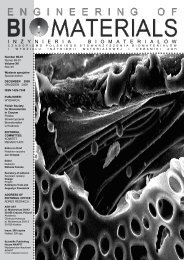69-72 - Polskie Stowarzyszenie BiomateriaÅów
69-72 - Polskie Stowarzyszenie BiomateriaÅów
69-72 - Polskie Stowarzyszenie BiomateriaÅów
Create successful ePaper yourself
Turn your PDF publications into a flip-book with our unique Google optimized e-Paper software.
In conclusion, both materials developed in this study<br />
seem to be good scaffolding materials promoting regeneration<br />
of auricular cartilage, although the quickest tissue<br />
regeneration was found after implantation of PLG-Hyal.<br />
<br />
Acknowledgements<br />
FIG.3. Histochemical pictures of PLG scaffolds<br />
(A) and PLG-Hyal (B) scaffolds 1 week after<br />
implantation; acid phosphatase (AcP) staining,<br />
optical microscope Olympus BH2, objective<br />
10x; s – scaffold, arrows indicate macrophages<br />
stained in red.<br />
The authors thank Dr. P. Dobrzyński (PAN, Zabrze) for<br />
providing polymer samples, Dr. W. Ścierski (Silesian Medical<br />
University, Department of Otolaryngology) for help in implantation,<br />
M. Żołnierek (Coll Medicum UJ, Kraków) for help in<br />
biological studies, Dr. C. Paluszkiewicz (AGH-UST, Krakow)<br />
for help in FTIR measurements and B. Trybalska, (AGH-<br />
UST, Krakow) for SEM evaluation. This study was supported<br />
by AGH-UST (grant number: 10.10.160.253).9<br />
References<br />
FIG.4. Histological pictures of PLG scaffolds (A)<br />
and PLG-Hyal (B) scaffolds 4 weeks after implantation;<br />
MGG staining, optical microscope Olympus<br />
BH2, objective 4x; s – scaffold, g – granulation<br />
tissue, c – cartilage, nc – neo-cartilage regenerating<br />
towards scaffolds.<br />
All animals survived the surgery. No wound healing<br />
complications were observed after the surgery and during<br />
the whole experiment.<br />
For histological evaluation tissue slices containing implanted<br />
scaffolds were stained with May-Grünwald-Giemsa<br />
(MGG), an acid-sensitive histological stain enabling visualization<br />
of inflammatory cells and evaluation of degradation<br />
process of aliphatic polyesters [9]. Moreover, histochemical<br />
staining for the activity of acid phosphatase was made in<br />
order to evaluate the number of inflammatory cells and the<br />
extent of inflammation in tissues around the implants.<br />
1 week after implantation both scaffolds were infiltrated<br />
mainly by neutrophils, e.g. cells predominant in acute inflammation.<br />
Inflammatory exudate in the implant site was<br />
observed. It was stronger in the case of PLG than in PLG-<br />
Hyal scaffolds. Macroscopically, bigger swelling was also<br />
seen around PLG implants. The activity of AcP was slightly<br />
higher in PLG-Hyal implants due to faster macrophage influx<br />
(FIG.3). It suggest, that more intense inflammation helped<br />
in tissue transformation, because it was clearly seen that<br />
PLG-Hyal scaffolds were better fixed in newly forming granulation<br />
tissue compared to PLG scaffolds. Both scaffolds were<br />
transparent and their microstructure was not changed.<br />
4 weeks after implantation the exudate was not present and<br />
the scaffolds were well settled in granulation tissue (FIG.4).<br />
Inflammatory cells such as macrophages, mast cells, eosinophils,<br />
and numerous multinucleated foreign body giant<br />
cells (FBGC) were observed close to the implants. Slices<br />
stained for AcP showed similar activity of the enzyme in<br />
tissues with both implanted materials. Macroscopically,<br />
the ears were much thicker in the case of PLG than in the<br />
case of PLG-Hyal implants. The scaffolds changed colour to<br />
brown indicating early degradation process of PLG polymer.<br />
New cartilage tissue regenerating towards the scaffolds was<br />
clearly visible.<br />
[1] Ciorba A, Martini A, Tissue engineering and cartilage regeneration<br />
for auricular reconstruction, Int. J. Pediatric Otorinolaryngology<br />
2006;70:1507-1515.<br />
[2] Romo T, Fozao M, Sclafani A, Microtia reconstruction using a<br />
porous polyethylene framework, Facial Plast. Surg. 2000;126:538-<br />
547.<br />
[3] Vunjak-Novakovic G, Martin I, Obradovic B, Treppo S, Grodzinsky<br />
AJ, Langer R, Bioreactor cultivation conditions modulate the<br />
composition and mechanical properties of tissue-engineered<br />
cartilage. J Orthop Res 1999;17(1):130-8.<br />
[4] Lee C-T, Lee Y-D, Preparation of porous biodegradable<br />
poly(lactide-co-glycolide)/hyaluronic acid blend scaffolds: Characterization,<br />
in vitro cells culture and degradation behaviors J Mater<br />
Sci: Mater Med 2006;17:1411–1420.<br />
[5] Dobrzyński P, Kasperczyk J, Janeczek H, Bero M, Synthesis<br />
of biodegradable copolymers with the use of low toxic zirconium<br />
compounds. 1. Copolymerization of glycolide with L-lactide initiated<br />
by Zr(Acac) 4 . Macromolecules 2001;34: 5090-5103.<br />
[6] Goldberg AF, Barka T, Acid phosphatase activity in human blood<br />
cells”, Nature 1962;195:297.<br />
[7] Pamuła E, Błażewicz M, Paluszkiewicz C, Dobrzyński P, FTIR<br />
study of degradation products of aliphatic polyesters-carbon fibres<br />
composites, J Mol Struct 2001;596:<strong>69</strong>-75.<br />
[8] Wang W, A novel hydrogel crosslinked hyaluronan with glycol<br />
chitosan, J Mater Sci: Mater Med 2006;17:1259–1265.<br />
[9] Schwach G, Vert M. In vitro and in vivo degradation of lactic acidbased<br />
interference screws used in cruciate ligament reconstruction.<br />
Int J Biol Macromol 1999;25:283–291.<br />
Injectable Cell<br />
Immobilization Systems<br />
for Bone Regeneration<br />
P.L. Granja 1 , M.B. Evangelista 1,2 , S.J. Bidarra 1 ,<br />
S. Guerreiro, C.C. Barrias 1 , D.J. Mooney 2 , M.A. Barbosa 1<br />
1<br />
INEB – Instituto de Engenharia Biomédica, University of<br />
Porto, R. Campo Alegre, 823, 4450-180 Porto, Portugal<br />
2<br />
Cell and Tissue Engineering Lab, Division of Engineering<br />
and Applied Sciences, Harvard University, Cambridge, USA<br />
[Engineering of Biomaterials, <strong>69</strong>-<strong>72</strong>, (2007), 5-6]<br />
Abstract<br />
Cell immobilization or encapsulation has been extensively<br />
investigated with the purpose of to providing<br />
immunoisolation but few attempts have been made to<br />
use this strategy for tissue regeneration.













